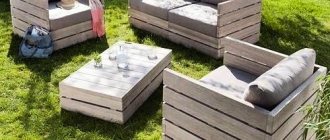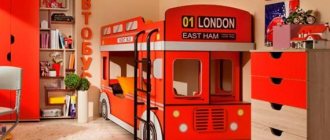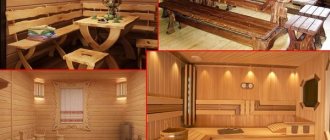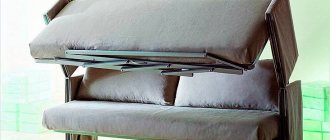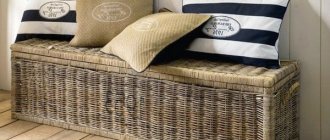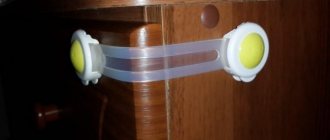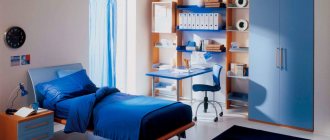Homemade security features
You can make devices that prevent doors and cabinets from opening with your own hands; for this you need to use your imagination.
Parents seal cabinets with duct tape or put rubber bands on handles, and hide the extension cord in a cardboard box. If you make furniture protective devices yourself, make sure they are reliable before use.
Option for homemade protection from corners of furniture using polyurethane pipe and tape:
Homemade protection option for drawers:
For door hinges
A separate type is a locking lock for door hinges. It is a spacer that is inserted between the door leaf and the door frame. The lock is hung on a hinge, thereby securing the door. It remains open.
Modern locks can protect the door from closing; any adult can install this device securely and quickly. When the device is removed, it will not leave any traces.
Locking devices for drawers
The most popular method of protection is special latches, one part of which is attached to the furniture frame using special Velcro, and the second half is attached to the front of the drawer. Such protective devices can be purchased in specialized children's stores. They are inexpensive, and not much time is spent on their installation. When the need for such latches passes, they can be easily removed, and not a trace will remain of them on the furniture.
It is possible to install handles on furniture or, for example, on windows with a special built-in lock. But this method is a little more complicated than described above, since you will need to find handles that would fit in place of the handles installed on the furniture. After you have bought such a handle, it is installed on the drawer, and it is simply locked.
How to repair a wardrobe if the doors roll back
DIY three-door wardrobe
Stoppers are used to secure closed sashes. These are special spring-loaded brackets in the grooves of the lower guides, which stop the roller in the desired position and prevent it from rolling back. With an unadjusted or broken stopper, the sash is blocked before it reaches the side wall or is fixed at all. As a result, the door does not close tightly.
To make the correct adjustment, close the sash, lift it slightly and mark the position of the roller with a pencil. Move the door to the side so it is out of the way. Now move the stopper, aligning it exactly with the center of the mark. To do this, press on one of the antennae with a screwdriver, and then push the stopper in the desired direction with your hand or a second screwdriver.
To keep the latch in place longer, remove it and bend the antennae wider - this way they will dig deeper into the profile and hold on tighter. To do this, lift the flaps up one by one and carefully remove them. Then unscrew the screws from the lower guide profile and remove it. Now the stopper can be pulled out by sliding it towards the edge.
If one of the retainer's antennae is broken, it will no longer stay in the guide. In this case, you need to buy a new stopper and replace it by removing the doors and taking out the profile as described above.
To prevent the stopper from moving, you can also fix it at the edges. To do this, drill through the hole with a thin drill and insert a nail there or simply screw in a small self-tapping screw.
Types of children's blockers
For windows
They do not allow the frame to be opened or inform the parent with a loud sound that the window has opened. You should choose them taking into account the type of window: rising, sliding, opening inward or outward.
Flexible devices
There is also a universal type of device; they cover windows, any cabinets and a refrigerator. They are made of flexible material and are attached using an adhesive base at a height that a tomboy definitely cannot reach.
For drawers
The lock will prevent the drawer from being pulled out, protecting children from the drawer falling on their feet when opened abruptly. Such devices are secured with small screws from the inside.
Using such locks live:
But such protection does not always work - the test drive from the girl Yana failed...
Corner clamps
They are used for various cabinets, they are attached to the side and do not allow the door to be opened, they are often made of plastic, but are reliable.
For toilet lid
Children love to wash their hands in the toilet and throw toys in it, but they will not be able to open the lid, which is secured with a toilet lid lock.
For doors
There are two types: some fix the door in a certain position, while others do not allow it to be closed completely. The second type is in great demand, as soft shock absorbers allow you to use the door as safely as possible.
Plugs for sockets
Thanks to this plug, the baby will not be able to put anything into the socket.
They can be made of plastic or rubber.
Review of protective devices from a wise dad:
Rosette handle - high-quality child locking of windows
Child protection on plastic windows is done by replacing the standard handle with a removable handle that has a plug in the form of a socket. Such fittings have a special locking device that protects the mechanism from outside influences. An important advantage of such a device is the ability to perform ventilation.
It’s not difficult to install the socket; you don’t even need to install additional fittings.
You can buy a similar handle anywhere (in a hardware store or a company that sells PVC structures and is involved in their installation or repair).
The part works like this:
- remove the holding device;
- insert a new element;
- tighten it with screws.
The fasteners are easy to find: they are hidden by a plastic plate located at the base of the handle.
This useful device has one obvious drawback: all parts of the fittings need to be stored somewhere so that they are not accessible to a child, but do not take much time for adults to search for. This fitting includes the handle itself, as well as the key with which the lock is released.
The cost of this protection against children is small, but can vary, depending on the country of the manufacturer, ranging from 600 to 2000 rubles.
How the handle works and the difficulties of its installation
Installation of protection on windows of this type can only be mounted with tilting structures, without a rotating mechanism. After closing the sash, the handle is removed and the hole is closed with a decorative plastic element. Such a system does not give the child a single chance of discovery.
Installation is also absolutely simple: the stationary handle is unscrewed, a new block is mounted, secured with only one bolt.
The pros and cons of rosette pens
All types of child protection on windows have pros and cons; removable handles also have these features. Only after carefully evaluating them can you purchase and then install such a device.
Advantages of a removable handle:
- pleasant appearance;
- the presence of a plug that masks the mounting holes;
- high level of protection.
Disadvantages of the pen:
- the constant need to attach and then disconnect the mechanism when opening or closing is required;
- there is a possibility of putting the fittings away and then searching for them for a long time when the need arises.
Door plugs
For a small child, the entire apartment is one continuous threat. And even such a seemingly harmless thing as a door carries a danger for him: a baby can, while holding onto the door, accidentally close it and get his fingers pinched.
Protection for interior doors also comes in different configurations, but the essence is the same - to prevent the door from closing. This can be a small prop that fits under the door, or a large, U-shaped rubber pad that fits anywhere on the door to prevent it from closing.
So, buying childproof furniture today is not a whim, but a necessity caused by the activity and curiosity of a rapidly developing baby. Remember: a pinched finger is the most harmless thing that can happen if you don’t take care of your baby’s safety.
Inspire us - share the material with your friends on social networks:
Read with this article:
Defense Mechanisms
The simplest devices for locking cabinet doors and cabinets can be made with your own hands. Our mothers and grandmothers used such simple methods using improvised means. Two adjacent door handles can be tied with a strong thick thread, rope or elastic band.
The disadvantage of this method is that the baby may well, over time, master the method of getting rid of such a “lock” and, with his own hands, open up access to the hidden depths of the furniture shelves. In addition, this is inconvenient for adults themselves, because the rope or elastic band will have to be removed every time you need to take something from the closet, and then re-attached to the handle.
Drawers or wardrobe doors can be blocked by gluing a strip of wide adhesive tape or insulating tape to their sliding surface. The disadvantages of this method are the same as those described above. In addition, the tape will leave sticky marks that are difficult to remove on furniture surfaces. You can curtain a chest of drawers or a cabinet with a large blanket or tablecloth.
The child will most likely see only a solid piece of matter and move on to more interesting things. This method is only suitable for very small and unintelligent children. It can be used as a temporary measure until more secure locking devices can be installed as soon as possible.
Sometimes furniture doors or drawers are equipped with mortise locks. Basically, such locks were often found in old furniture. In this case, you just need to find the key and do not forget to close the lock on the furniture with it after each use. Keep keys to cabinets and shelves out of the reach of small children. And of course, it is very undesirable to forget the storage location or lose the treasured key. In this case, taking the necessary items from bedside tables and chests of drawers will no longer be possible for an adult. However, modern furniture manufacturers do not often embed locks into drawers and doors.
If possible, it is better to take care of such furniture in advance by choosing the appropriate model or having it made to special order. It is not entirely advisable to embed such locks into existing furniture. The difficulty is choosing the lock itself.
Buy or make it yourself
In order to save money, many parents simply tie up the handles of door cabinets with ropes and various rubber bands, prop up the doors with improvised devices, and use classic furniture locks with keys.
I see a huge advantage in ready-made solutions over homemade ones. They are truly safe, tried and tested for effectiveness and performance. Plus, such systems have an attractive appearance and a thoughtful method of fixation. If you can do something similar with your own hands, make the locks yourself.
Subscribe to our website, leave comments, ask relevant questions and expect a lot of new and interesting materials!
Loading…
Are they really necessary?
Many parents have become convinced of the convenience and safety of using locking devices for furniture doors and drawers. When there is a little explorer in the house, you should not skimp on safety measures. Moreover, manufacturers provide a very wide range of locks and locks for cabinet doors and drawers.
In addition to the fact that such devices and mechanisms protect the baby from injuries and dangers associated with heavy or sharp objects, chemicals from cabinet shelves, they also relieve parents from forced cleaning. While exploring the spaces of a chest of drawers or drawers, the baby often leaves behind a decent mess.
Parents of especially active and inquisitive little ones have to put things in order and do cleaning several times a day. Before mom has time to sort out the clothes thrown out of the drawer, the sound of tubes of cream and bottles of eau de toilette falling to the floor, or even the sound of a broken cup, can already be heard from the next room.
Scolding a child for his natural interest in his surroundings is almost the same as scolding a person for wanting to sleep or eat. The development of intelligence and physical functions is inextricably linked with the practical study of the world. The baby actively moves, looks at, touches objects, and drags them into his mouth. He does this not at all out of conscious mischief, and not out of a desire to deliberately annoy you. Remember this. Do not limit the child in his natural development by making scandals and scolding him for sloppiness.
Although it’s a rare mother who manages to contain her anger and irritation after yet another misstep by the fidget. The baby does not have the skills to carefully handle objects, but he will learn just this and much more throughout the first months and years of his life. You can make this process mutually enjoyable, interesting and safe enough for your child only with the protective help of parents.
For an overview of child safety locks on drawers in action, see below.
Time to work hard
When exactly is the best time to inspect your own home and take measures for the safety of your child? There are different opinions on this matter. The best option is to do everything necessary before the baby is born. Or by the time the child starts crawling.
You can do things a little differently. Go through all the rooms of the house in advance and make a list:
- number and types of latches, clamps, blockers;
- what security gates are needed and how many;
- things that need to be moved to the top shelves of cabinets.
With a ready list, you can immediately go to the store and buy everything you need. Later, when this or that element is needed, it will be easy to find and install it in the right place.
In a safe home, parents won’t have to constantly run after their baby shouting “You can’t go there!” and be afraid of every step of the little explorer. And the child himself will be able to fully engage in understanding the world around him in order to grow up healthy and smart.
Summarize.
Closing the closet from the child
Hinged cabinet doors are also better protected from children. Otherwise, leaving him alone for a minute, you risk returning to the room to find a pile of linen from the lower shelves and your little one happily frolicking with him. As a rule, U-shaped latches are installed on swing doors.
This is the simplest method of protection, since it does not require drilling holes in the furniture, or even gluing the protection to the surface of the furniture.
You can also use latches in the form of plastic hooks. They consist of two parts: the first part is attached to one cabinet door, and the other - the hook itself - is installed on the other door. When the doors are closed, the cabinet is locked with a hook.
The closet door can also be locked. A mirror on a wardrobe is a very attractive item for a baby. Usually, small children enthusiastically roll closet doors, look at their reflection in the mirror, and drag all the things from the lower shelves to the floor.
Of course, devices that are installed on hinged cabinets are not suitable for sliding wardrobes. But still, today there is protection for such furniture. The most popular type of security for sliding wardrobes is the butterfly latch. It is installed on one of the doors, next to the second door. When the “wings” are lowered, the cabinet door is in a movable state. By pressing a special button, the “butterfly wings” rise and prevent the cabinet door from rolling.
Fastening rules
To ensure the safety of a child, you should not only use locks and furniture protections, but also do it correctly. To prevent fastenings from breaking, you need to follow several basic installation rules:
- check the quality of the purchased device: integrity of packaging and expiration dates;
- select the necessary materials and equipment;
- first you should prepare the surface of cabinets and doors;
- clean the site of intended attachment from grease and other particles using acetone;
- when the part consists of two parts, then you need to mark the attachment points so that they are on the same level;
- remove the protective film from the adhesive tape on the blocker and attach it to the surface of the furniture with a slight movement;
- If the glue has hardened, you can heat the attachment point. This can be easily done using a hair dryer;
- hold the lock in this state for several minutes;
- check the reliability of fastening by performing the typical actions.
If one of the stages of the technology is violated, the quality of fastening will be unreliable. Sometimes there is a need for additional materials for fixation: superglue, bolts. If the attachment is incorrect, it is better to change the attachments.
On an adhesive base
For screws
The need to protect furniture
A small child finds everything that happens around him interesting, so situations often arise that threaten the baby’s health. The time when children begin to crawl and walk is considered especially dangerous, since the danger will be from sharp corners and doors of furniture, sockets, and household appliances. Young children especially actively begin to explore the world from the contents of the closet and shelves. Some things can be removed or moved higher, but the sharp corners of tables, sofas, chairs, and drawers remain.
To reduce the risk of injury to a child, caring parents resort to tricks - installing protection, limiters and blockers. Sometimes such devices are made independently, but a more reliable option is special products that can be purchased at hardware stores.
Types and models of blockers
Locking locks are designed for hinged sashes and doors. Depending on the type of handles on the doors, they come in different shapes. These locks are very easy and quick to install on cabinet handles and securely hold the doors in the closed position. Door locks of this type look neat and will not damage your furniture. They do not tear or stretch when opened and closed multiple times, and are quite strong and durable.
For sliding doors and drawers in a chest of drawers or cabinets, soft Velcro locks are suitable. They are attached to the side and front surfaces of the furniture and connected with a special fastener, thereby keeping the drawer from sliding out. Depending on the model, the locking mechanisms may be different: special hidden buttons, hooks and ears. Locks of this type can also be used to lock the doors of kitchen appliances that are dangerous for children (refrigerator, microwave oven, oven). After all, the baby is unlikely to limit his travels to the living room and his children's room.
To protect the child from a heavy box falling on his feet, you can attach special latches that block the extension. Even if a young fidget somehow manages the lock blocking the drawer, the latch will work when pulled out and will not allow the drawer to be pulled out of the cabinet too far. Such devices are attached to the inside of the furniture and block the movement of the drawer to a certain amplitude. Fastening is carried out either using bolts or using holders glued to the inner surface of the box
More expensive models of locks and security devices are often equipped with a special built-in sensor that emits an audible signal when an attempt is made to open incorrectly (pulling the handle while the lock is closed or applying force to the mechanism itself). The intensity and type of sound signal can be adjusted through the settings. For vigilant parents, this is undoubtedly a significant advantage.
(no votes yet)

